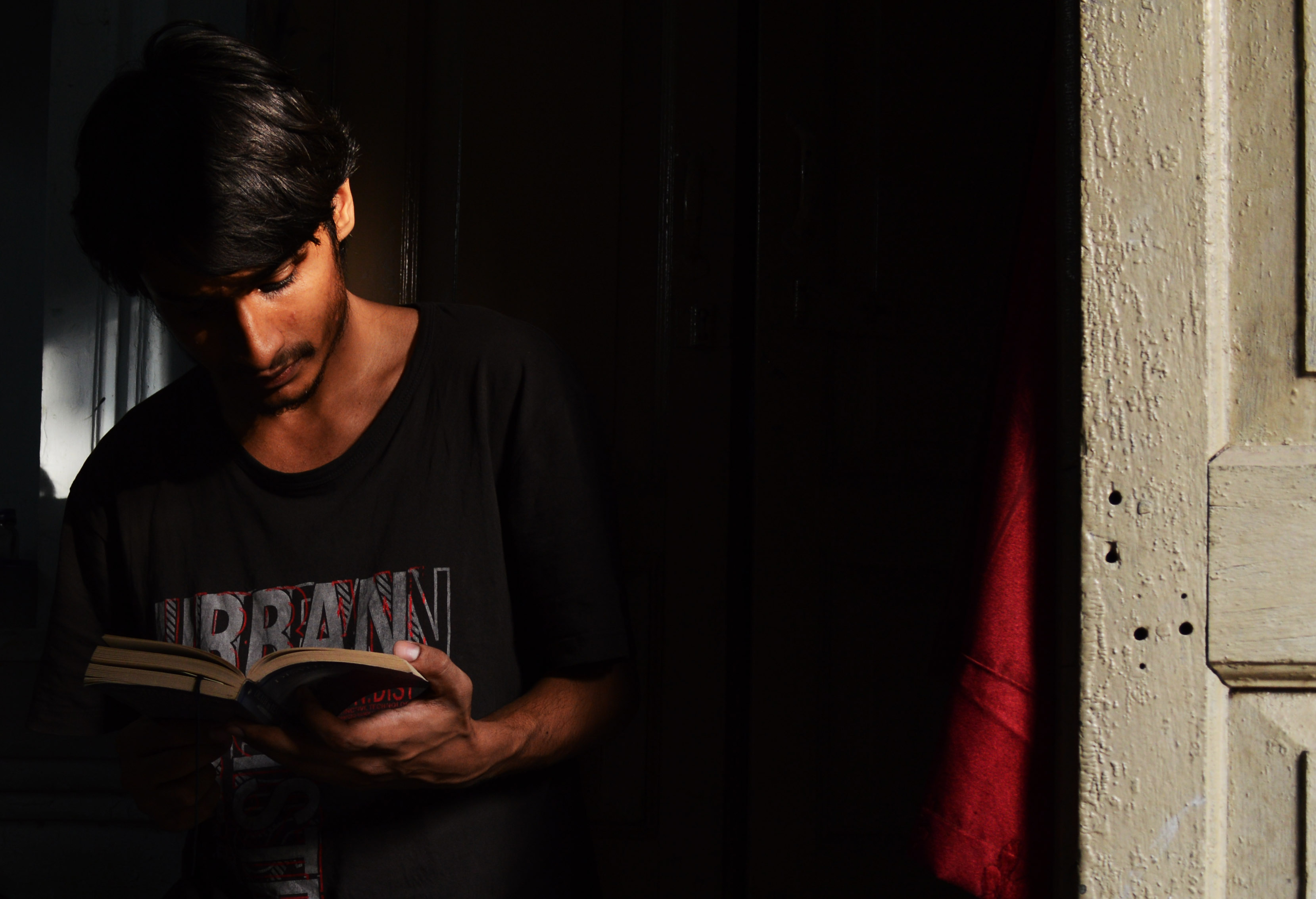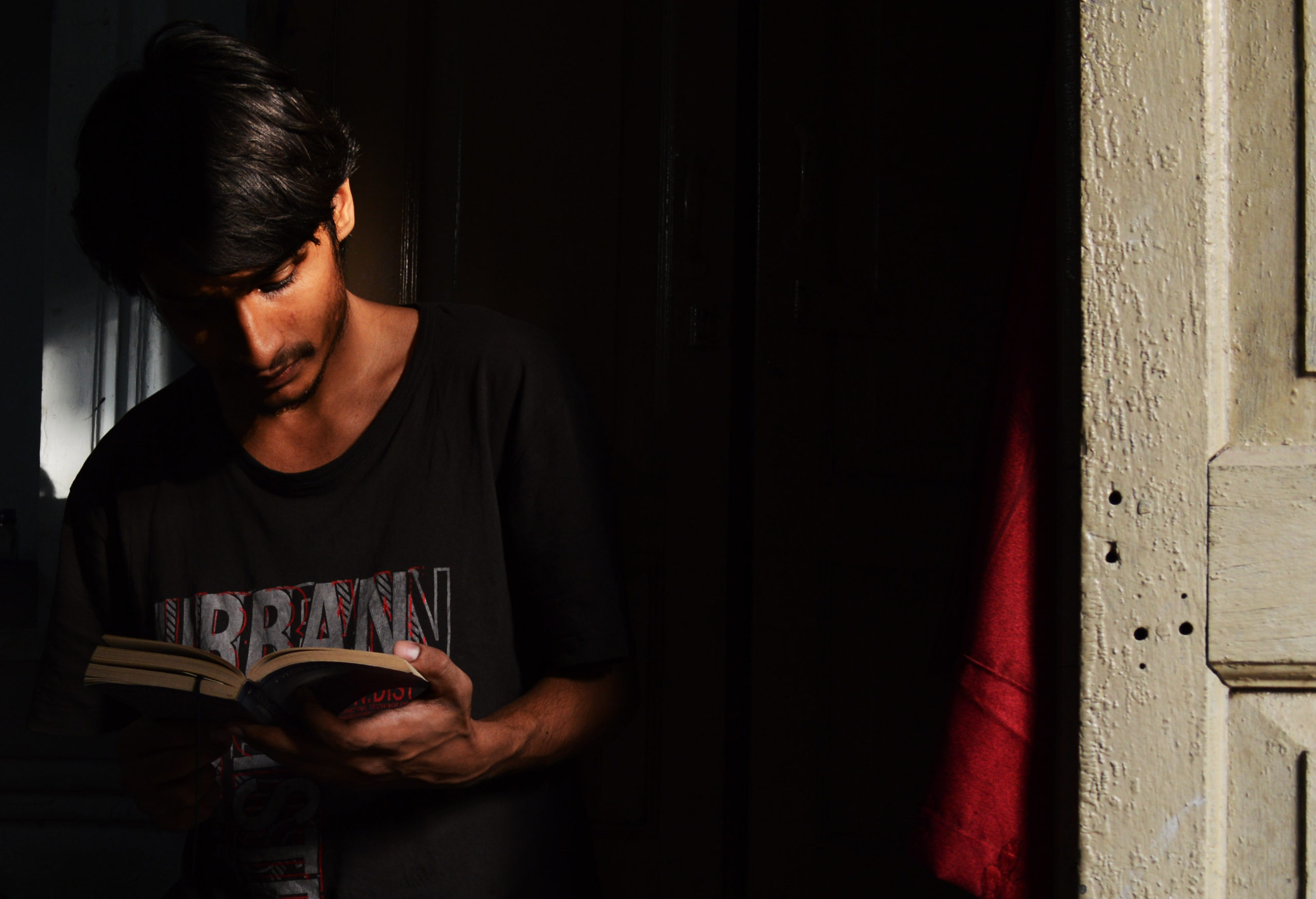
A spare, moving story about a young man’s crisis of meaning, Girah (directed by Darpan Bajaj and Moksh Krishnan) is an award-winning short film put together on a tiny budget by students at the University of Delhi’s College of Art. We spoke recently with the writer and lead actor of the film, Achintya Malviya.
SCOPE: Girah is a remarkable film and we’ll certainly be talking about it, but first help me out with some personal context. You’re a painter by training – so in thinking about your childhood, what got you started on your creative path? And why painting in particular?
ACHINTYA MALVIYA: If I think about it, there are a few factors that brought me to the field of art and painting. The family I come from has produced three generations of poets and writers. My father [Yash Malviya] is a renowned Hindi poet and so were my grandfather and my uncles. But this art of creative writing has found its way to the third generation as well. I don’t know how; I might put the blame on genes and call this hereditary…
So, from the day I started understanding things better, my urge to express what I felt grew simultaneously, though I hadn’t yet found the medium through which I would be expressing myself. Initially I never knew it was going to be painting. But I have always enjoyed the fact that when an emotion is expressed through art it becomes a thousand times more powerful, how art adds a greater value and sometimes an entirely different perspective to look at some of the most ordinary things in life which would, otherwise, never be noticed. So art became just like another language I understand, and I prefer to convey certain feelings through it. As I grew up, I developed a great interest in sketching, probably because my elder brother, who was a voracious reader and now a sociologist as well, was very much influenced by the great people he used to read about, and admired these greats so much that he used to draw really small portraits of people like Marx, Gandhi, Einstein, etc. I was more interested in his drawings than in what he studied. I was mesmerized to see how just a few pencil strokes, when brought together, can resemble things we see in real life. This is perhaps how I also started sketching, which eventually took me further to painting as well. Frankly, I have always been more inclined towards sketching.
But at the same time, these are the reasons, I can only believe, that are responsible for pushing me into painting. Although I can never be sure. Maybe it just happened. Perhaps I wouldn’t really want to know the answer. I’m just glad I started painting, whatever the reason. Like poetry: you wouldn’t really want to read a text explaining the deeper meaning of a poem or simplifying it, instead you would want to understand the poem in all its poetic sense.
How did you become involved in short films? What attracted you about the form?
When I cleared the entrance exam of the college I just graduated from (College of Art, University of Delhi) four years back, I had very little knowledge about what other departments there were in the college. I knew only about the department of Painting, Sculpture and Print Making. It was only after I started attending classes that I found they had Applied Art, Art History and Visual Communication Departments as well. The Visual Communication department had graphic designing, photography, animation and all sorts of things which were, directly or indirectly, related to film making, in their syllabus. I had friends from the department of Visual Communication who were already engaged in film making and had some experience in the same (most of them were the ones I later made Girah with). What they required was someone who could write stories for them, as stories and scripts are the first and most important “hero” of a film. And what stories need are people who have good technical knowledge to execute them in the best possible way. As I have already told you, I used to write as well and I was fascinated by the idea that I would also be able to “see” my story, not just read it. So that’s how me and my friends came together to make short films.
It makes me sad that the art of painting that I practice, or as a matter of fact any other art form, is limited to art galleries and only elite classes of society have access to it or can afford it. That’s not the case with cinema or street art. That is why I have always admired and had respect for these art forms. Also, you don’t have to be very well educated to understand cinema. It is an art form which reaches to the most ordinary, and that is exactly what I love about it.
How was the experience of acting in both Rang and Girah? Was it easy for you?
Well, let me tell you that I’m not an actor, and I have never acted before in my life. Which is why I was really nervous when my friends asked me to act in the movie Girah. So, last year, when we were just discussing about short films, or cinema in general, and the whole idea of making a film was just a fantasy, what we all agreed upon was that if we wished to dabble in film making, we’d have to keep the budget of the film as low as possible because we were just students who were still very much financially dependent upon their parents and families and we couldn’t spend much money on making a film when we were already investing a good amount of money on college education and all kinds of art materials. So we agreed upon not hiring professional actors; instead, one of us would have to do the job. Also, while writing Girah, keeping the budget as low as possible was my first priority. Eventually my friends, in search of a person who could act, turned towards me, saying that I was the one who wrote the story and therefore I understood the character much better than anyone else on the team. That’s how I ended up acting in Girah.
The experience of acting in Girah was actually the exact reciprocal of what I expected. When the shooting began, being kind of a shy person I was pretty nervous and uncomfortable. But it didn’t take me long to get comfortable because I knew I was acting in front of people who were great friends of mine and I had already been really weird in front of them, several times. Acting was still very low on the scale of being weird. Though Girah is based on a very serious topic, we had our moments of laughter on the set. All those discussions about how we were going to avoid continuity errors, from which direction light would be falling upon the characters and who is going to hold the lights, deciding the frame and camera angels, marking the points where I would have to stand still and smoke a cigarette, and marking the outer limits within which I could walk around… It was so much fun! So even today when I watch Girah, it’s not what’s there on the screen that I see, it’s what’s not there in the frame, what we decided to cut… like if there’s an open window in the frame and a light bulb is flickering, giving the feel of a gloomy atmosphere, what I see is my friend Arun standing just outside the frame, abruptly turning the light switch on and off. And my friends were right: since I wrote the story, the characters, the emotions behind the film, came from nowhere else but were my own creation. I could feel those emotions. I was able to be the person I created, with much ease. So the shoot went really smoothly, with very few retakes.
After Girah, Rang was much easier for us… Girah still took a few weeks to complete, but Rang was made within a day.
How has the film been received by viewers and the press? Were you expecting this?
I think – in fact, all of us who were a part of Girah think – that we failed at promoting the film well enough. So it has reached a smaller audience. Quite frankly, Girah was never meant for a large audience; we knew that the film was a little too subtle for a general “office-going middle class” audience to receive it. I remember after the whole team finished watching Girah for the first time, before we made it public, we were just casually discussing what we were going to do with the film, what film festivals we’d be sending it to… and also, how we expected people were going to receive it. We all had somewhat similar expectations. We all thought that we would get extreme reactions: either they were going to love the film or they would completely hate it. Nobody would call it just an “okay” film.
Girah got an official selection in the 3rd Delhi International Film Festival and also won the Special Jury Award in the Prayag International Film Festival, as you might have already seen on Behance. It was much appreciated by the critics in both these film festivals; people loved the cinematography, the editing, and the story. The only negative responses that we received were what we expected, that a good part of audience might not be able to understand it. A few people said that they had to watch the film more than once to understand what exactly happened! Apart from that, people loved the film and found it a technically-sound and well-edited film with an impactful story.
Follow Girah on Facebook here. See Achintya’s paintings on Behance here.

